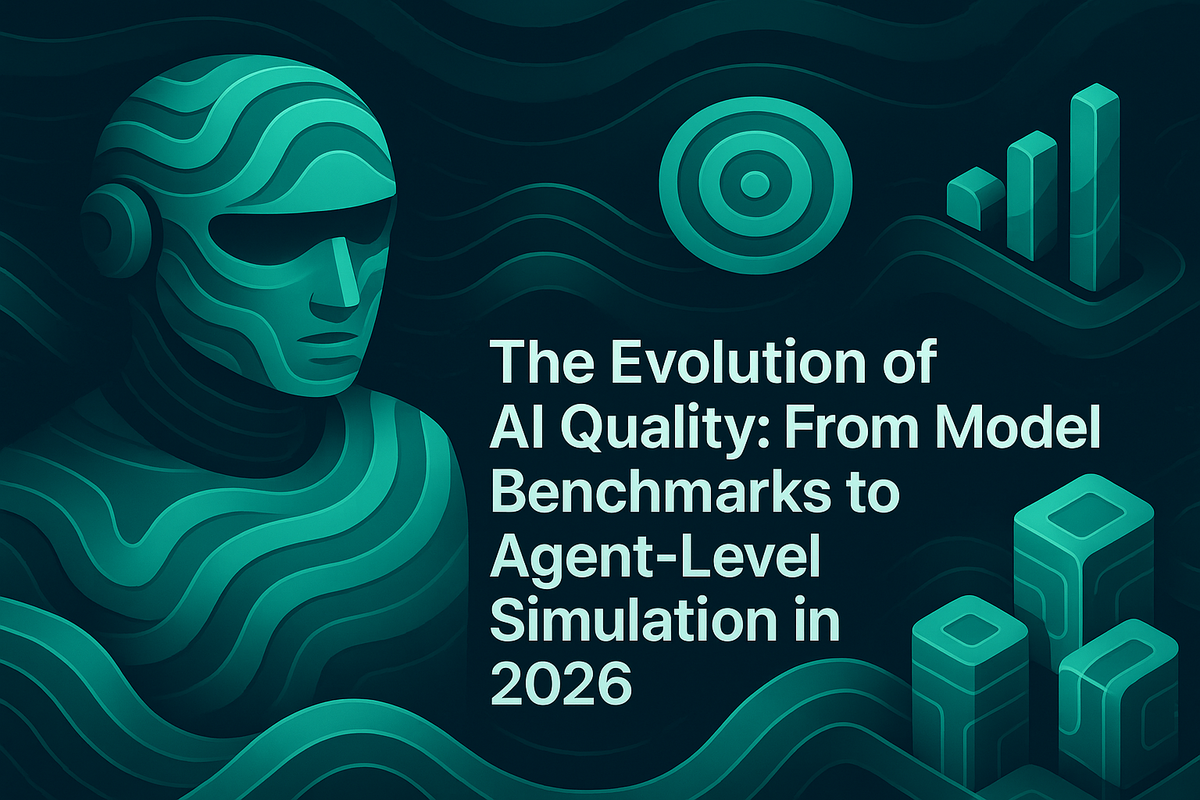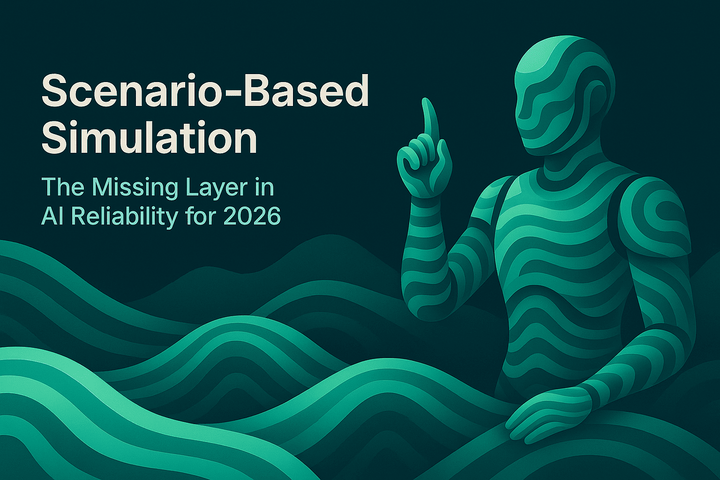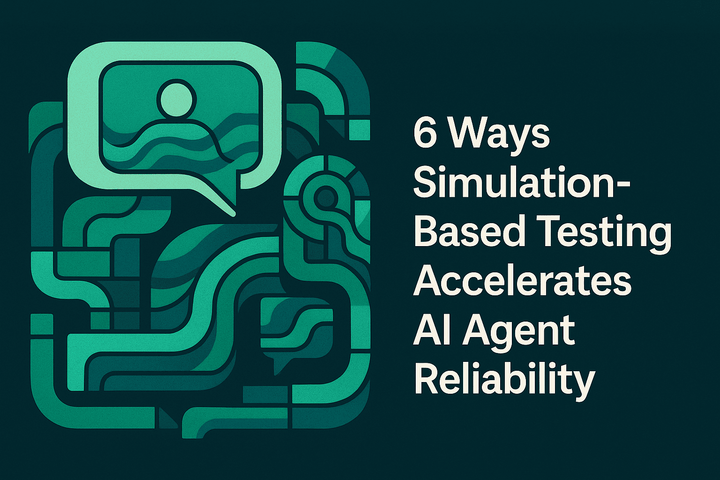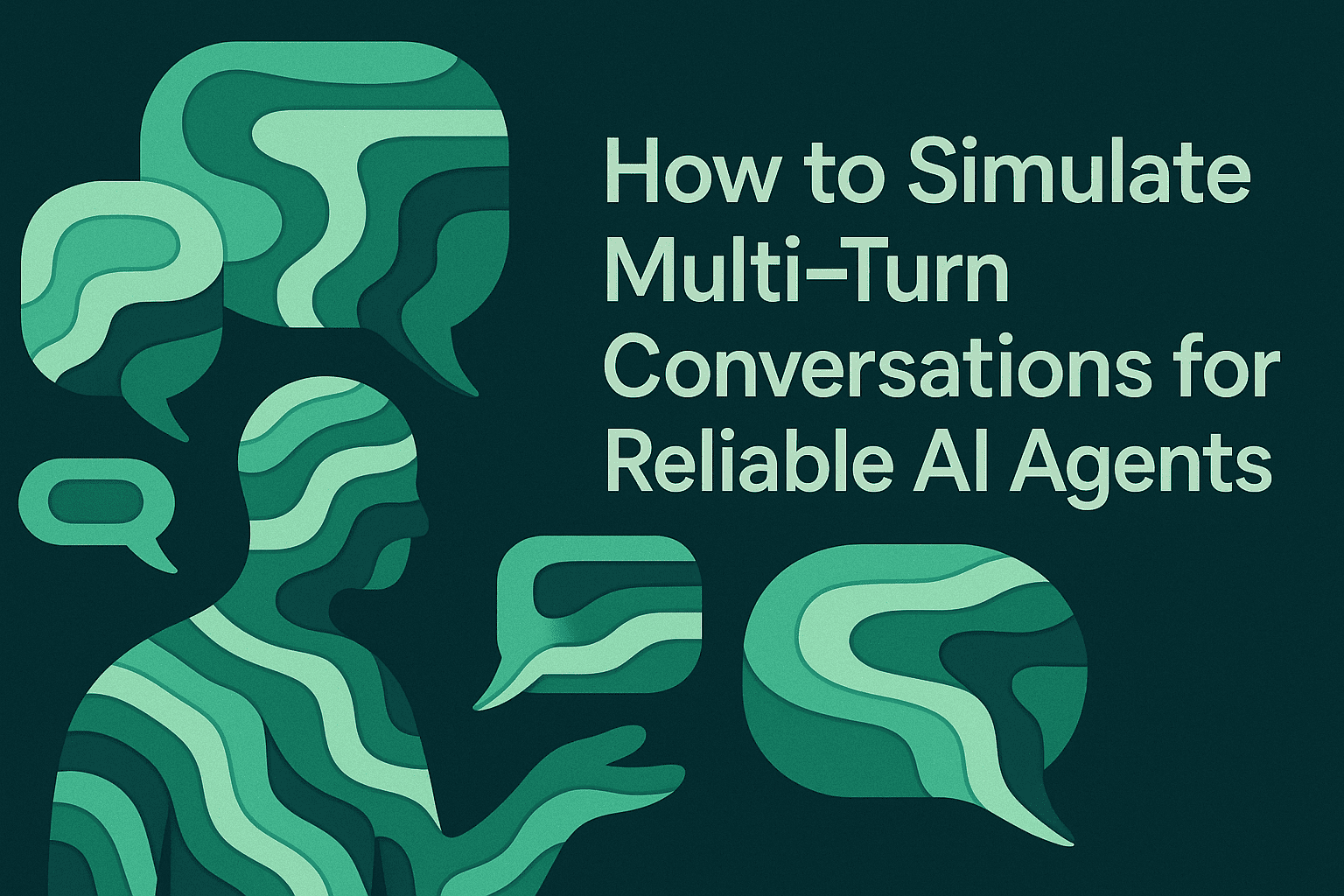The Evolution of AI Quality: From Model Benchmarks to Agent-Level Simulation in 2026

Building trustworthy AI no longer stops at model scorecards. In 2026, the standard for AI quality shifts decisively from static model benchmarks to agent-level evaluation, simulation, and observability across real user journeys. Teams need to understand multi-turn decisions, tool calls, retrieval context, and failure recovery, not just whether a model can ace MMLU. This article explains the agent-first quality stack, why it is necessary, and how engineering and product teams can operationalize it using simulation, evals, and LLM observability.
Why model benchmarks alone are not enough
Model-level benchmarks (e.g., accuracy on curated datasets) are useful for comparing raw capabilities, but they miss context and control in production. Agents plan, choose tools, fetch knowledge via RAG, and adapt to unexpected outcomes. Quality, therefore, depends on the end-to-end trajectory, not a single answer.
- Community frameworks like the EleutherAI LM Evaluation Harness help standardize model evaluation across tasks, but they assume a controlled prompt→response loop and typically target single-turn metrics. They do not measure tool-call correctness, persona alignment, or recovery behavior under error. See the community repo: EleutherAI LM Evaluation Harness and a recent integration guide: Integrating benchmarks into LM Evaluation Harness.
- For retrieval-heavy systems, quality hinges on retrieval relevance and response faithfulness. Surveys and new benchmarks describe the complexity of evaluating RAG, including component- and system-level metrics: Evaluation of Retrieval-Augmented Generation: A Survey and RAGBench: Explainable Benchmark for Retrieval-Augmented Generation Systems.
Agent-level quality requires measuring whether the agent completed a task robustly, with correct tool usage, grounded answers, safe behavior, and acceptable latency/cost, across realistic, multi-turn conversations.
What “agent-level” evaluation entails
An agent-centric evaluation strategy moves beyond static datasets to replayable, realistic simulations aligned with production behavior. Core elements include:
- Multi-turn personas and scenarios with explicit success/failure criteria.
- Tool stubs and sandboxes that include schema changes, timeouts, degraded responses, and error injection.
- Adversarial probes (prompt injection, conflicting evidence) and imperfect information.
- Session-level metrics (task success, safety adherence, trajectory quality, latency/cost) and node-level metrics (tool-call validity, retries/fallback behavior, retrieval quality).
Maxim AI’s simulation approach is documented here: Agent Simulation & Evaluation and the technical guide: AI Observability Platforms: How to Monitor, Trace, and Improve LLM-Powered Applications. A deep overview of how to construct credible simulations, evaluators, signals, and CI/CD integration is available in: Agent Simulation: A Technical Guide To Evaluating AI Agents In Realistic Conditions.
Are LLM-as-a-judge evaluations reliable?
LLM-as-a-judge has become common for scalable scoring of open-ended outputs. Two recent studies highlight important reliability considerations:
- Reliability depends on design choices and sampling; fixed randomness can mislead. Can You Trust LLM Judgments? Reliability of LLM-as-a-Judge shows the need for multiple samples and rigor (e.g., using consistency metrics such as McDonald’s omega).
- Evaluation criteria clarity matters more than Chain-of-Thought in many cases; non-deterministic sampling improved alignment with human preferences. See: An Empirical Study of LLM-as-a-Judge: How Design Choices Impact Evaluation Reliability.
Best practices we recommend:
- Use mixed evaluators: deterministic/statistical scores (e.g., exact match, schema adherence, latency) plus LLM-as-a-judge with well-defined rubrics, and route edge cases to human review.
- Sample multiple judgments when using LLM-as-a-judge and measure inter-rater reliability against human baselines.
- Ground eval prompts in scenario-specific criteria to reduce ambiguity.
Maxim’s unified evaluation framework supports programmatic, statistical, LLM-as-a-judge, and human-in-the-loop evaluators at session/trace/span levels. See product page: Agent Simulation & Evaluation.
RAG evaluation: retrieval, generation, and system coherence
RAG systems introduce compounding failure modes. Evaluating RAG must cover:
- Retrieval: relevance, accuracy across candidates, rank-based metrics like MRR/MAP.
- Generation: faithfulness to retrieved documents, answer relevance, and correctness.
- System: how retrieval improves response quality, latency, and resilience under ambiguous or complex queries.
For a practical overview of RAG metrics and dataset strategies, see Maxim’s guide: Evaluating RAG performance: Metrics and benchmarks with additional background from the comprehensive survey: Evaluation of Retrieval-Augmented Generation: A Survey and benchmark design in RAGBench.
Maxim supports rag evals, rag tracing, and dataset curation from production logs to build golden suites that evolve with your application. Explore: Agent Simulation & Evaluation and Agent Observability.
Observability and tracing: the foundation of trustworthy AI
Agent-level quality depends on seeing what the agent is actually doing in production. AI observability combines distributed tracing, payload logging, automated evals, and human review queues to detect regressions early and debug issues quickly.
- With distributed tracing, teams can investigate session-level and span-level behavior, analyze tool calls, and correlate prompt versions to outputs, crucial for agent debugging, llm tracing, and voice tracing in streaming scenarios. See: LLM Observability: How to Monitor Large Language Models in Production and product page: Agent Observability.
- Observability supports online evals on sampled production traffic, alerting on quality regressions, and mining failures into datasets for targeted offline re-runs. A practical blueprint is covered in: AI Observability Platforms: How to Monitor, Trace, and Improve LLM-Powered Applications.
This approach aligns with industry standards like OpenTelemetry semantic conventions and enterprise reliability goals, while addressing the unique risks of hallucination detection, content safety, and trustworthy AI in agentic workflows.
Voice agents: observability and evaluation considerations
As voice agents grow, quality becomes multi-dimensional: streaming latency, transcript accuracy (WER), naturalness (MOS), tool-call timing, and user interruption handling. Observability must capture audio spans, partial hypotheses, final ASR outputs, and downstream actions. Pair automated checks (WER/MOS proxies, policy triggers) with human review for subjective aspects.
You can run voice evals, trace audio spans, and set alerts on latency and content safety using Maxim’s observability + evaluation stack. See: Agent Observability and implementation guidance in AI Observability Platforms: How to Monitor, Trace, and Improve LLM-Powered Applications.
The role of an AI gateway in reliability and governance
A production-grade AI gateway unifies multi-provider access, adds resiliency (automatic failover), and reduces cost via semantic caching and model routing, while centralizing governance. Maxim’s gateway, Bifrost, offers an OpenAI-compatible API for 12+ providers with enterprise controls:
- Unified access and drop-in replacement: Unified Interface and Drop-in Replacement.
- Reliability & performance: Automatic Fallbacks, Load Balancing, and Semantic Caching.
- Governance: Budget Management, SSO Integration, Observability, and Vault Support.
- Tool interoperability via Model Context Protocol (MCP) for external tools (filesystem, web search, databases): Model Context Protocol (MCP).
A robust gateway is complementary to ai observability and agent monitoring, giving teams control over cost, access, and reliability while instrumenting model calls and tool actions end-to-end.
A practical 2026 roadmap for AI quality
The path to agent-level quality includes repeatable steps that integrate with development, release, and operations:
- Foundations
- Identify critical user journeys and encode them as multi-turn scenarios with clear success/failure criteria.
- Instrument tracing for sessions/spans/generations/retrievals and log structured payloads with redaction.
- Stand up baseline evals: faithfulness, answer relevance, tool-call correctness, latency/cost.
- Depth and realism
- Add personas, adversarial probes, and degraded tool behaviors; adopt agent simulation to replay and scale coverage.
- Mix evaluators (deterministic/statistical + LLM-as-a-judge) and add human-in-the-loop reviews for high-stakes criteria.
- Begin online evals on sampled production traffic; configure alerting for regressions in ai reliability signals.
- Production loop
- Convert production traces into reusable simulations; evolve a golden suite for regression checks.
- Use prompt versioning and prompt management to compare variants and track improvements across releases.
- Govern costs, rate limits, and access via the ai gateway; adopt model router strategies by workload.
For detailed implementation guidance, see Maxim’s product pages:
- Experimentation and prompt engineering: Playground++ Experimentation.
- Agent simulation and evaluation: Agent Simulation & Evaluation.
- LLM observability and production monitoring: Agent Observability.
Where Maxim AI fits
Maxim AI is an end-to-end platform for ai simulation, evals, and observability, designed for cross-functional engineering and product teams. It helps teams ship multimodal agents more than 5x faster by unifying pre-release experimentation, agent simulation and evaluation, and real-time llm monitoring and agent observability.
- Full-stack for multimodal agents: comparing prompts/models/parameters, running replayable simulations, and monitoring quality in production with agent tracing and llm tracing.
- Flexible evaluators: off-the-shelf, custom deterministic/statistical, LLM-as-a-judge, and human-in-the-loop, configurable at session, trace, or span level.
- Data engine: curate and evolve datasets seamlessly using logs, eval data, and human feedback, enabling continuous improvement.
- Enterprise-grade: SOC2, RBAC, SSO, in-VPC options, and auditability.
- Gateway (Bifrost): multi-provider routing, semantic caching, failover, observability hooks, and governance through an OpenAI-compatible API. Explore: Unified Interface, Provider Configuration, Governance, and Observability.
Conclusion
The next frontier of ai quality is agent-level: measuring whether agents achieve goals reliably and safely across realistic, multi-turn journeys with tools and retrieval. Static model benchmarks remain useful, but teams now need simulations, agent evaluation, and ai observability connected to production signals, anchored by an ai gateway for resiliency and governance. By adopting these practices, engineering and product teams can deliver trustworthy AI experiences at scale.
Ready to operationalize agent-level quality across experimentation, simulation, evaluation, and observability?
- Book a demo: Maxim Demo
- Start building: Sign up on Maxim


